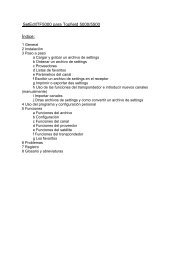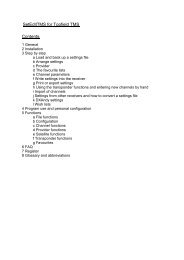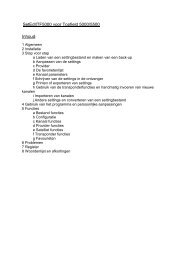SetEditFDU-HD for FDU-receiver and compatible Contents:
SetEditFDU-HD for FDU-receiver and compatible Contents:
SetEditFDU-HD for FDU-receiver and compatible Contents:
You also want an ePaper? Increase the reach of your titles
YUMPU automatically turns print PDFs into web optimized ePapers that Google loves.
8 Glossary <strong>and</strong> abbreviations<br />
Baud rate: The speed at which data is transferred via the serial port to the <strong>receiver</strong>. The number is in<br />
bits per seconds.<br />
Decimal/Hexadecimal: Hexadecimal is a system <strong>for</strong> representing numbers in base 16, rather than the<br />
base 10 we normally use. The hexadecimal system requires 15 digits <strong>and</strong> a zero; conventionally the<br />
letters A-F are used to represent the digits <strong>for</strong> that the decimal system cannot provide equivalents.<br />
Hexadecimal notation is not usually important <strong>for</strong> the PC user (with the possible exception of<br />
specifying base addresses) but is still quite important <strong>for</strong> the programmer. Its importance arises<br />
because there is a very close correspondence between hexadecimal <strong>and</strong> the very important binary<br />
numbering system that computers use internally. However, hexadecimal notation is much more<br />
compact than binary.<br />
The reason why you can select both systems in SetEdit is that many satellite operators use "even"<br />
hexadecimal PID numbers. For example the audio PIDs on Astra transponder 11720 are in decimal<br />
notation 256, 512, 768, 1024, 1280 etc., whereas in hexadecimal notation they are 100, 200, 300, 400<br />
etc.<br />
DLL: Dynamic Link Library. A Windows library file that can be shared by multiple applications.<br />
FEC: Forward Error Correction. A system, in which redundancy is added to the message so that most<br />
errors can be corrected dynamically at the <strong>receiver</strong>. Usual values are 1/1, 1/2, 2/3, 3/4, 5/6 <strong>and</strong> 7/8.<br />
3/4 means that 3 out of 4 bits are reference data <strong>and</strong> the remaining one is <strong>for</strong> error correction.<br />
LNB: Low Noise Block (converter). Amplifies received signals <strong>and</strong> converts them from microwave to<br />
lower frequency signals that are then sent along a cable to the satellite <strong>receiver</strong>. An LNB can be either<br />
single or double. A double LNB is required when more than one <strong>receiver</strong> is used allowing the viewing<br />
of different satellite channels on other television sets.<br />
PID: Program Identifier. A 13-bit code in the transport packet header. PID 0 indicates that the packet<br />
contains a PAT PID. PID 1 indicates a packet that contains CAT. The PID 8191 (all 1 bits) indicates<br />
null (stuffing) packets. All packets belonging to the same elementary data stream have the same PID.<br />
The most important PIDs are the Video PID (<strong>for</strong> the video in<strong>for</strong>mation), the Audio PID <strong>for</strong> the sound<br />
<strong>and</strong> the PCR PID (Program clock reference) to get Video <strong>and</strong> audio synchronous.<br />
If you enter an existing Service ID <strong>for</strong> a channel, the <strong>receiver</strong> can get all necessary in<strong>for</strong>mation <strong>for</strong> this<br />
channel. If you only enter the video <strong>and</strong> the audio PID, it may happen that you see the picture <strong>and</strong><br />
hear the sound, but EPG does not work because this in<strong>for</strong>mation is transmitted on a different PID.<br />
Usually the <strong>receiver</strong> finds the PIDs automatically, but occasionally (exotic channels) you have to know<br />
them <strong>and</strong> enter them by h<strong>and</strong>.<br />
Symbol rate: The amount of digital data that is transmitted per second via a transponder. This is<br />
specified in Msymb/sec (Mega symbols per second), whereby a "Symbol" consists of 4 bits. The<br />
symbol rate together with the FEC value can be used to calculate the b<strong>and</strong>width of a transponder.<br />
Polarity: A satellite transmission signal has either a vertical, horizontal, or circular orientation; a<br />
satellite can be all vertical or all horizontal; if a satellite is cross polarised, it can transmit both ways<br />
<strong>and</strong> there<strong>for</strong>e has twice the delivery capacity.<br />
Besides the horizontal <strong>and</strong> vertical polarisation we also find the circular polarisation. Circular<br />
polarisation is not as easy to underst<strong>and</strong> as linear polarisation, you can imagine that the waves are<br />
rotating clockwise or anticlockwise. In this case we speak about LHC <strong>and</strong> RHC (left h<strong>and</strong> circular <strong>and</strong><br />
right h<strong>and</strong> circular).<br />
As a rule in Europe linear polarisation (horizontal <strong>and</strong> vertical) is used. In Sc<strong>and</strong>inavia <strong>and</strong> <strong>for</strong> C-b<strong>and</strong><br />
reception circular polarisation is used.<br />
Select: To select a channel please click with the mouse on the channel. To select more than one<br />
channel you can use the usual windows methods.<br />
When you press the shift key <strong>and</strong> click on a channel all channels between the currently selected <strong>and</strong><br />
the last selected channel are selected.<br />
If you press the Ctrl key on the keyboard you can add single channels to your selection.






